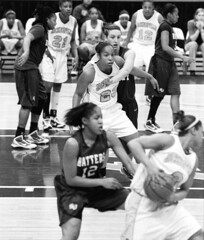 Last week Forbes published a widely read article (over 15, 000 views) called “Ten Ways to Turnaround a Dysfunctional Team” by Eric Jackson. Much of the piece was solid, if unspectacular advice, such as, “Don’t have too many meetings,” “Hold people accountable,” and “Measure progress.” Not much to argue with there. However Mr. Jackson’s first two recommendations - “Get rid of non-performers immediately” and (in so many words) “Fill the vacant roles with the best people possible” – merit some discussion.
Last week Forbes published a widely read article (over 15, 000 views) called “Ten Ways to Turnaround a Dysfunctional Team” by Eric Jackson. Much of the piece was solid, if unspectacular advice, such as, “Don’t have too many meetings,” “Hold people accountable,” and “Measure progress.” Not much to argue with there. However Mr. Jackson’s first two recommendations - “Get rid of non-performers immediately” and (in so many words) “Fill the vacant roles with the best people possible” – merit some discussion.“Get rid of non-performers immediately.” Sometime hard decisions have to be made and individuals have to be let go for the sake of the company as a whole. Yet it is rarely that simple. There are many reasons why it might be nearly impossible (or spectacularly unwise) to “get rid” of a particular person. Different jurisdictions and different workplace environments (unionized or not) have different rules and conventions around letting people go. There are other things to think about as well. What if you are working in a family business and the “non-performer” is the boss’s sister – or your own sister? What if the person you have identified as a problem is an old fraternity buddy of someone higher up in the hierarchy?
Mr. Jackson writes that you will engender goodwill among the others if you get rid of the “cancerous” members of the team. But there is a difference between a “non-performer” and a “cancerous” or difficult person who brings down everyone around them. If the non-performer is well-liked, getting rid of him or her is bound to demoralize the others. Forget about any “goodwill.” On the other hand, the difficult, widely disliked person might in fact be your top performer. Mr. Jackson performs a little rhetorical slight-of-hand when he identifies “non-performers” with “cancerous” members of the team. (And don’t get me started on his choice of metaphor here…)
A better approach? Find out why the non-performer or the weak performer isn’t doing better. Maybe he has problems at home and this is a temporary setback. Maybe she just isn’t suited to the role and needs some kind of change. A friend who has worked for several years in the banking industry tells me that over the years she has moved many people from sales into administration. All of these were good workers who simply weren’t comfortable in sales. Once you have identified why non-performers aren’t doing better, you might have some idea of how the situation might be turned around.
“Fill the vacant roles with the best people possible.” Every company wants to hire “the best people,” just as all parents wants their child to be the smartest in the class or the most valuable player on the hockey team. But we all know that, in the real world, not every company will be able to hire “top talent.” Your organization might be at a geographical disadvantage; you might simply not be able to afford to pay the kind of salary that top talent can demand. By all means, hire the best people you can find and the best people you can afford. But you hardly need me (or anyone else) to tell you that.
I see another problem with Mr. Jackson’s suggestion. It seems to assume that the way to have a great team is to make sure it is filled with the “best” people. This seems like common sense. If you want to bake a cake, assemble the best ingredients and you will get the best results. But a workplace team is not like a cake. A group of excellent individuals might not be able to form a great team. They may not be able to work together effectively. They may undermine, rather than support one another. They may be hesitant to share ideas or offer necessary critical feedback. If you are in the position of having to turn around a dysfunctional team, it is not enough to make sure you have the best people. You’ve also got to make sure that they are interacting in a productive and respectful manner.
Turning around a dysfunctional team is hard. It is a real test of managerial skill. If it could be done in ten easy steps, every company would be successful.
 You may have heard that Tuesday night’s performance by the New York Philharmonic at Avery Fisher Hall was abruptly halted because of a stubbornly loud and persistent cell phone. The orchestra was playing the final movement of Mahler’s Ninth Symphony, considered by some to be one of the most emotionally rich and sublime pieces of music ever written. Towards the end, at the worst possible moment, the insistent plinking of the iphone “marimba” ringtone completely shattered the atmosphere. Alan Gilbert, the conductor of the Philharmonic, actually stopped the performance and glared at the offender until he managed to silence the phone. (You can read an amusing account of the evening
You may have heard that Tuesday night’s performance by the New York Philharmonic at Avery Fisher Hall was abruptly halted because of a stubbornly loud and persistent cell phone. The orchestra was playing the final movement of Mahler’s Ninth Symphony, considered by some to be one of the most emotionally rich and sublime pieces of music ever written. Towards the end, at the worst possible moment, the insistent plinking of the iphone “marimba” ringtone completely shattered the atmosphere. Alan Gilbert, the conductor of the Philharmonic, actually stopped the performance and glared at the offender until he managed to silence the phone. (You can read an amusing account of the evening